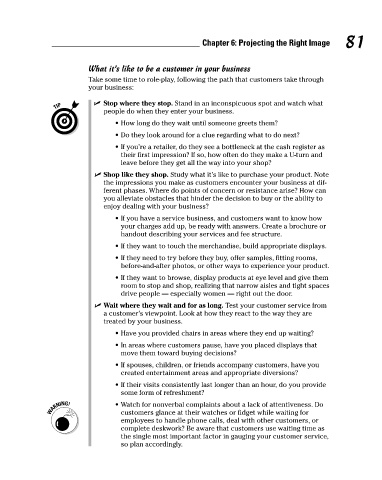Page 97 - Duct Tape Marketing
P. 97
81Chapter 6: Projecting the Right Image
What it’s like to be a customer in your business
Take some time to role-play, following the path that customers take through
your business:
ߜ Stop where they stop. Stand in an inconspicuous spot and watch what
people do when they enter your business.
• How long do they wait until someone greets them?
• Do they look around for a clue regarding what to do next?
• If you’re a retailer, do they see a bottleneck at the cash register as
their first impression? If so, how often do they make a U-turn and
leave before they get all the way into your shop?
ߜ Shop like they shop. Study what it’s like to purchase your product. Note
the impressions you make as customers encounter your business at dif-
ferent phases. Where do points of concern or resistance arise? How can
you alleviate obstacles that hinder the decision to buy or the ability to
enjoy dealing with your business?
• If you have a service business, and customers want to know how
your charges add up, be ready with answers. Create a brochure or
handout describing your services and fee structure.
• If they want to touch the merchandise, build appropriate displays.
• If they need to try before they buy, offer samples, fitting rooms,
before-and-after photos, or other ways to experience your product.
• If they want to browse, display products at eye level and give them
room to stop and shop, realizing that narrow aisles and tight spaces
drive people — especially women — right out the door.
ߜ Wait where they wait and for as long. Test your customer service from
a customer’s viewpoint. Look at how they react to the way they are
treated by your business.
• Have you provided chairs in areas where they end up waiting?
• In areas where customers pause, have you placed displays that
move them toward buying decisions?
• If spouses, children, or friends accompany customers, have you
created entertainment areas and appropriate diversions?
• If their visits consistently last longer than an hour, do you provide
some form of refreshment?
• Watch for nonverbal complaints about a lack of attentiveness. Do
customers glance at their watches or fidget while waiting for
employees to handle phone calls, deal with other customers, or
complete deskwork? Be aware that customers use waiting time as
the single most important factor in gauging your customer service,
so plan accordingly.

